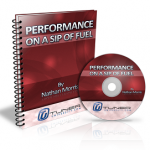In the last 3 parts of this article series we've focused mostly on wheel choice and it's effect on your car's performance. However, in this part we're going to talk about the most important component of your car, the tires. Up until now, tires have kind of been in the background of the discussion but now it's time to bring them to the foreground where they belong in your modification journey.
I have to get it off my chest first and foremost that I am sick of seeing guys who have spent hundreds, even thousands of dollars on their various performance modifications only to fit cheap tires on their car.
The tires on your car are the ONLY interface between your entire car and the road. They are what transfer power to the road, stop you when you hit the brakes, and hold you in the corners. More than any other component, they affect your car's performance.
In fact, if you could do only one performance modification to your car, I'd suggest strongly that you leave everything alone and change the tires to the stickiest summer tires you can find (for a street car), or a purpose built race tire. No matter what other modification you do, you will not get the same bang for your buck as the investment in good tires.
Now that we've established to some degree why the tires are so important, let's talk about selecting tires.
Tire Grip
Everyone says that wider tires give you more grip as it puts more rubber on the ground. However, that is incorrect. Even if it were correct, we'll discuss in a few moments why more rubber on the ground usually doesn't matter anyway.
Actually, the patch of that touches the road is directly related to tire pressure and the weight on the wheel. So for example, a 850 lb load on your driver side tire at 33psi has a tire patch of 27.75.. square inches. The shape of that patch will vary depending on the width of that tire, but regardless of the tire you fit, that's the patch of rubber that will be touching the ground.
We calculate the size of the patch by dividing the weight on the tire by the tire pressure. Extremely stiff sidewall tires (ie extremely low profile) will deviate from this a bit and actually give the effect of having more tire pressure (ie, less tire patch on the ground). Hence the reason I advice against using less than a 40 or so section height tire. You can actually also use this same math to cheaply estimate the corner weights of your car, but we'll discuss that at another time.
So in short when you fit a wider or more narrow tire, what ultimately changes is the shape of the contact patch. The patch gets wider horizontally and shorter on the vertical direction.
Does Tire Grip Increase Due to More Rubber on the Road?
No. For most practical circumstances (I mean, obviously if you had 2mm of rubber on the road that'd be an issue), despite being unable to really get more on the road due to the reasons listed in the above section - the primary limiting factor for grip is, the tire's compound.
We will discuss tire compound a bit more in the next section but for now, we need to understand that GRIP is a function of the coefficient of friction (a number that describes how sticky the tire is) multiplied by weight. We can't do much about weight, but we CAN do something about the coefficient of friction by altering the tire compound.
By the way, don't miss the weight issue. Interestingly, lighter cars require less grip because they have less mass to try to pull away in the corners. However, they also can generate less grip. So, for our discussion here, we'll focus on the coefficient of friction - or, simply, the tire compound.
Why Wider Tires and Narrow Sidewalls? Temperature. Not Grip.
The reason cars are fitted with wider tires with smaller sidewalls is not related to grip as we've proven. Instead, it's related to temperature. Many people are familiar with the idea that sidewall height affects tire temperature. What is less known is that width also has a huge role in tire temperature and sidewall wear.
When a tire is too narrow, the contact patch is very long (up and down in line with the tire tread) but not very wide (across the tread). Now think about the tire patch, if we have a wide tire then a thin "slice" across the tire tread is touching the ground. However, if we have a narrow tire, then the slice is actually turned 90 degrees so that more of the tread face is touching the ground at once. It sort of looks like a flat tire if that helps you imagine what we're looking at.
As the tire rotates this means that more of the tread is in contact with the road and it has less time to cool as it turns in the air. Therefore, tires that are too narrow tend to run too hot.
Deformation and wear is another issue created when the tire is too narrow.
In order for the tire to create the patch size we calculated area this means the sidewall will need to"squish" quite a bit to compensate for the excessively narrow tire. Much like a fat kid sitting on a bicycle if you can imagine. This puts a lot of stress on the sidewall and as rotates it's essentially crushing and uncrushing the sidewall over and over again.
When the tire is widened to the proper size we get a more square even distribution of tire on the road and the sidewall will not be constantly getting crushed as the tire rotates. This keeps temperatures down and significantly reduces wear.
Therefore, yes, there is an up side to a wider tire but it's not what you might have thought at first. You'll notice that cars intended for the track (high end sports cars) and cars that are particularly heavy are the ones you see being fitted with reasonably fat tires from the factory.The choice is always made for either heat or weight considerations.
You might be asking why heat matters aside from preventing wear and blow outs. Well, glad you asked. The softer rubber you use, the less resistant to heat it is. Therefore, if you use too narrow of a tire you have to use a harder rubber compound. Harder rubber compounds have higher coefficients of friction (in other words, lower grip). So, if you are a manufacturer or tuner that wants to fit fairly sticky tires, going up one or two tire sizes might not be a bad idea if the original tire compound was rather "hard".
One example might be on a Civic. A Honda Civic likely came with all season or fairly tame summer tires. They might have a tread wear rating of say, 300-400. We want to fit some really sticky Bridgestones with a wear rating of maybe 180 or so. This would be a good place to go up one maybe even two tire sizes in width to give ourselves some improved tire cooling.
On a car like our Project IS300, the car came with reasonably sticky tires from the factory. Therefore, one tire size in width up might be nice but the stock size is probably more than adequate.
Compound
Similar to brake pads, all tires are made from slightly different rubber compounds depending on what they're designed for. Unfortunately, while tire technology has come a huge way in the past decade, we still do not have a tire compound that gives optimum grip in all conditions.
You're already probably familiar with general street tire compound types. There are rubber compounds for winter time (snow+ice), summer time, and then there's everyone's favorite - the all season tire.
As you might expect, winter tires are best when the temperatures outside are quite cold and are even aimed at driving on snow and ice.
Summer tires are ideal for when the temperatures are higher and are intended for dry warm road surfaces.
All seasons, well, they try to be all things to all people. However, like any "all purpose" item, they really only turn out to be mediocre at all things and not very good at anything in particular.
If you're a motoring enthusiast, you should be running summer tires. Period. If you live in an environment where you get a lot of snow, then in the winter you need to switch out to winter tires but keep a set of summer tires for when summer comes back around.
Why summer tires? Well, summer tires are intended to provide maximum grip on a dry warm surface and love when they get warmed up from some spirited driving.
I do not have much experience with snow due to the area that I live in. However, I do know from the limited snow we get that summer tires are useless in snow.
As a general rule, when selecting a summer tire you can check the tire's "rating" numbers. They are usually given like this: 180 A A. The first number is the one we're most interested in. 180 refers indirectly to how soft of a tire compound this tire has. It also directly refers to how long it will last, with the lower number being a faster wear life.
Despite the faster wear, if we're looking for maximum performance, we generally want the lowest tread life wear number possible (within reason).
You will notice that DOT legal race tires have numbers like 60 or perhaps the manufacturer hasn't even bothered to rate them. This is because if you drive them on the street, they will only last a few thousand miles before you are beyond the legal tread depth minimum.
However, on the flip side, if you notice a tire you're about to choose has more like a 250-400+ tread wear rating, you're probably looking at a tire compound that is too hard for optimum performance. It'll last a lot longer, but it will not give you that high end sports car handling you desire.
Don't get me wrong, there are some excellent all season and summer performance tires that will last you a long time - but they're a compromise from the ultimate in grip.
Unfortunately, there's no real way to get amazing grip from tires and also have them last forever at this time - yet.
Brand Selection
Honestly, there are several brands that make excellent summer performance tires. From year to year, the top dog changes. However, if you want to know what the best tires available for you right now are, head over to TireRack and review their tire reviews. As a general rule, you want their "Extreme Summer Performance" rated tires (their naming system is extremely confusing).
You'll find that Pirelli, Bridgestone, and Yokahoma generally own the market for super agressive, super sticky rubber.
The TireRack reviews are always pretty comprehensive and also talk about issues regarding noise and comfort level. I wouldn't just select the 'fastest' tire from the group immediately as road noise and ride comfort are also very important in a street car. I'm more than happy to give up a completely unnoticeable amount of grip for a nicer ride.
We could discuss tread patterns, but aside from saying that less tread is better, there's no way to really give you advice on those except to read reviews from places like TireRack. I also recommend you ask around on the amateur club racing forums - especially for the street tire class guys. They'll have more experience with a tire than anyone, and they won't have any marketing spin to throw your way.
Right now, it looks like the Bridgestone RE-11s are about as good as you can get followed closely or perhaps equaled by the Yokahoma Advan tires. They will be the tires replacing the set of all season tires currently on Project Lexus.
If you must run an All Season tire, look at the Pirelli P Zero Nero - for an all season with a very long wear rating, we like these quite a lot.
In Closing
In any case, again, if you can't afford to do mods and buy "expensive" tires then forget the other mods and instead get the tires. You'll be improving the performance of your car far more that way. You'll affect your braking, acceleration, and handling - and very few mods can claim that sort of wide ranging effect.
'Cheap' Korean tires start to look a lot less like a bargain when you compare the performance they give you with a solid performance tire.
As mentioned in a previous part of this series, one final note is never buy tires based on their weight. I've seen some enthusiasts thinking that lighter is ALWAYS better and buying cheap tires because they're light. While at first that makes sense, it doesn't make sense when you find out why they're so light - they lack much internal reinforcement. They are also made of inferior rubber compounds. If you have two very good tires an you just can't decide between the two, then look at weight. Otherwise, don't bother.
Let Me Know What You Think
Please let me know what you thought of this article, ask questions, get involved. The more feedback I get the more I can tailor these articles to your interests. If nothing else, the quick thank you's are always nice to read.
See you guys again on Friday for this next installment.
Extremely Limited Time Offer - 3 Days Only
Get a MASTERS DEGREE in Performance Tuning from the BEST in the Field for ONE low package price
For 3 days only, get ALL of our PREMIUM (not available anywhere else) Tuner University Courses featuring some of the greatest minds in motorsports:
- Top 10 Performance Myths Class (MP3 and Edited Transcript) - $29.95 value
- Performance on a Sip of Fuel Class (MP3 and class manual) - $69.95 value
- Header Design Secrets with John Grudynski (MP3 and transcript) - $69.95 value
- Dirty Secrets of Oil with Ryan Stark (MP3 and transcript) - $69.95 value
- Engine Tuning Secrets with Ben Strader of EFI University (MP3 and Transcript) - $69.95 value
Get all of the above courses (many of which not currently available anywhere else) for one single price of just $309.75 $69.95. A HUGE package savings.
You can also buy any of these individually through our resource center, but I don't know why you would as this is basically the whole store for the price of just 1 course. You'll get the MP3 recordings of each class as well as a transcript or companion manual with each course and you'll be able to download them all INSTANTLY.





